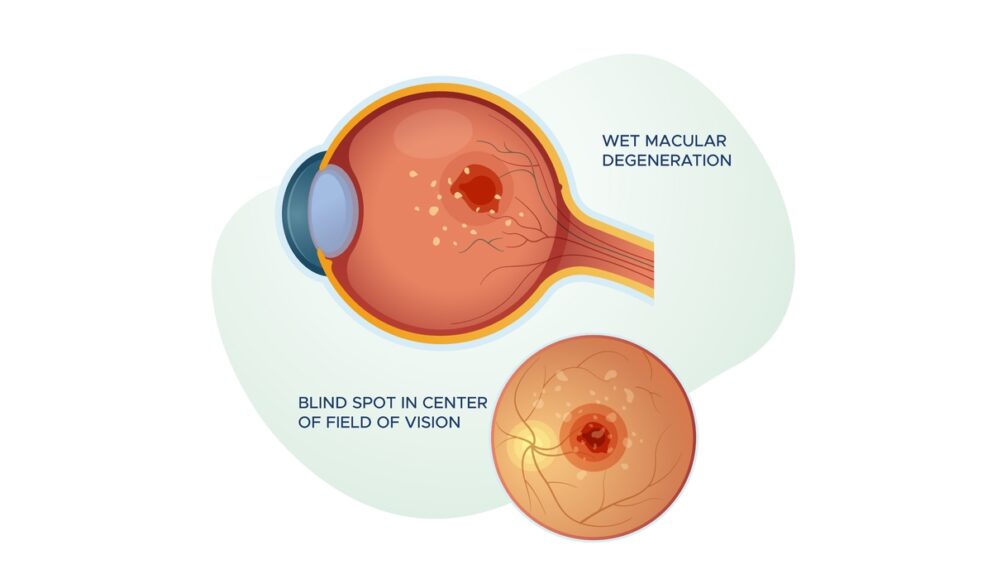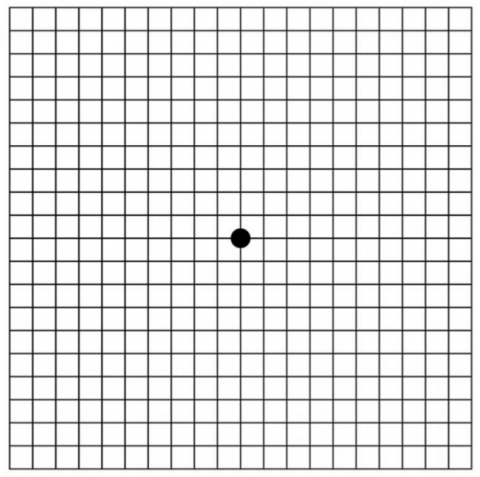Signs & Symptoms
Age-related macular degeneration (AMD) is an irreversible destruction of the central area of the retina, called the macula, which can lead to blind spots and distorted central vision. Continue reading to learn more about the symptoms and why early detection is so important.

Together, We Can Stop Macular Degeneration
As many as 20 million Americans have macular degeneration. Your support helps fund research studies to defeat this disease and provide vital information to the public.
What to Watch For
During the early stages of AMD, particularly if only one eye is affected, you may not have symptoms. Macular degeneration does not cause pain to help suggest that something is wrong.
An eye doctor may be able to detect early signs of the disease before symptoms appear. Therefore, regular eye examinations are critical to detect these signs as soon as possible.
Early Warning Signs of Macular Degeneration
At first, the dry form of AMD often causes slightly blurred central vision, both close up and far. The center of vision may become fuzzy or shadowed, and this area grows larger as the disease progresses. Blind spots may develop, and people normally have more difficulty seeing color and fine detail.
Visual field defect
The wide angle of vision that a healthy eye can see is called the visual field. As macular degeneration progresses, the center of a person’s visual field may become smudged, distorted, or lost. This defect causes problems with reading, driving, watching TV, and recognizing faces.
Contrast sensitivity
It becomes more difficult to see textures and subtle changes in the environment. If you cannot see slight contrasts and textures in pavements or stairs, it can be dangerous and increase the risk of falls. You may have difficulty distinguishing between two colors of a similar hue when placed side by side.
Poor tolerance for changing light levels
It may become difficult for your eyes to adjust when driving and walking at sunset, or when going from a well-lighted room to a darker one. Glare can worsen the problem. For example, a bright shaft of sunlight streaming through a window may cause everything outside the glare to “blackout.”
Need for higher light levels
You may need brighter light levels for reading, cooking, and performing day-to-day tasks.
Impaired depth perception
An inability to judge distances properly can also make walking harder, potentially leading to missteps and falls.
Is it Wet AMD?
Wet AMD is a more severe form of the disease where abnormal blood vessels grow behind the macular as retinal pigment epithelial cells and photoreceptor cells die. In addition to the above signs, straight lines may appear wavy and central vision loss can occur rapidly, sometimes within days or weeks.

Early Detection Can Protect Sight
In addition to regular eye exams, you can detect early signs of macular degeneration at home using an Amsler grid. The tool uses a simple grid pattern to show spots in your field of vision. If you notice any changes to your vision, you should have your eyes checked by an ophthalmologist.

Do You Think You or a Loved One Might Have Macular Degeneration?
If you suspect that you or a loved one is experiencing changes in their central vision, seek advice and a thorough evaluation by an ophthalmologist. It’s important to get early medical attention if you can.
Search for a Macular Degeneration Clinical Trial
Clinical trials are crucial to advancing the most effective medical approaches. Today’s studies will lead to new standards of care in the future.

Resources
Recent Resources & Information

Downloadable Resource
Amsler Grid Eye Test
Download a free Amsler grid, an at-home eye test that can help detect early signs of retinal disease such as age-related macular degeneration (AMD).

Juvenile Macular Degeneration
Learn about Stargardt disease and Best's disease, two forms of macular degeneration that affect children and young adults.

Expert Information
What’s New for Treating AMD?
Those with advanced dry AMD, also called geographic atrophy (GA), currently have no effective treatments available to them but several may become available this year.

Expert Information
Less Common Symptoms of Age-Related Macular Degeneration
If you have these vision issues, especially when waking up, you may be showing less common symptoms of macular degeneration.

Macular Chats
Understanding Dry AMD and Geographic Atrophy
Hear from Dr. David S. Liao, a board-certified ophthalmologist at the Retina-Vitreous Associates Medical Group who specializes in the medical and surgical treatment of diseases of the retina and vitreous.

Expert Information
Macular Degeneration: Signs & Symptoms
Discover the early signs and symptoms of age-related macular degeneration (AMD), from blurred vision to impaired depth perception. Regular eye exams are crucial for early detection.





